
(Photo by Stephen Alvarez, from National Geographic, March 2008)
The current (March 2008) issue of National Geographic contains an intriguing article, Beyond the Blue Horizon, by Roff Smith, about the earliest colonizers of the Pacific. Many of us who have an interest in indigenous boats know something about the renowned navigational and seamanship skills of the Polynesians, and it's easy to picture boats not too much unlike the familiar Polynesian canoe doing the work of exploration and colonization a thousand or two years ago. According to the article, however, that wasn't necessarily the way it was.
As much as 30,000 years ago, the far western Pacific, covering New Guinea, Australia, and the Solomon Islands, had already been settled by peoples originating in Taiwan. There they stayed until 1300 BC or so, when a people now called the Lapita rather suddenly, and in very small but well-equipped groups, set out to intentionally colonize points east, island-hopping as far as Fiji, Tonga, and Samoa, where they quickly wiped out a huge number of species but apparently lived comfortably for all that. The islands in this area are close enough to one another so that insightful mariners would have had a number of good clues that something existed not too far over the horizon, and this would have given them the confidence to set out on voyages of discovery. The whole wave of colonists numbered only a few thousand and, when spread across the hundreds and hundreds of islands that they colonized, population density never appeared to have been a problem or the incentive to keep moving. They left some very nice-looking pottery but, alas, no boat artifacts.
There the migration stopped for 1200 years or so, until the people whom we now know as the Polynesians once again moved east into Polynesia, ultimately going as far as Hawaii, Easter Island, and even South America (there is, according to the article, good evidence for this last). The islands in this region are much further separated from one another than in the western half, and voyages of discovery would have been much iffier propositions, fraught with far more danger and uncertainty. The driving mechanism of the migration is disputed. It could have been intentional wanderlust enabled by the confidence born of good seamanship and boats capable of tacking into the wind, or random dispersal caused by bad luck and an inability to avoid being blown to windward. No one knows what the boats were like, or whether they had rigs capable of tacking into the wind. The latter theory, however, seems weak, when one considers that every inhabitable island throughout the eastern Pacific was in time inhabited. It's hard to credit the notion that every island population was the result of an unplanned "voyage" by some hapless couple (and there must have been both genders aboard, not just a single fisherman) who just managed to survive and make landfall after weeks or months of aimless drifting.
Unfortunately, virtually nothing is know of the boats used by either the Lapita or these early Polynesians -- not a single scrap of a boat artifact has been recovered from the former, and literally just a few scraps of one boat from the latter -- not enough to reveal anything about the sailing rigs used. But unless one accepts the "random bad luck" theory, it would appear that as much as 3300 years ago, the ancestors of the Polynesians were already competent mariners with competent boats -- if only we could learn what they were like!










No comments:
Post a Comment